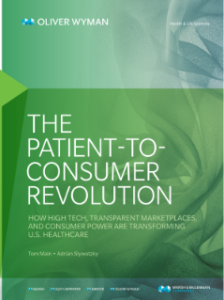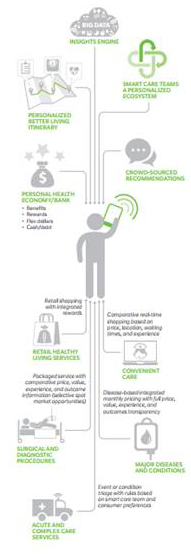 Oliver Wyman’s Health & Life Sciences group names its latest treatise on the new-new health care The Patient-to-Consumer Revolution, subtitled: “how high tech, transparent marketplaces, and consumer power are transforming U.S. healthcare.”
Oliver Wyman’s Health & Life Sciences group names its latest treatise on the new-new health care The Patient-to-Consumer Revolution, subtitled: “how high tech, transparent marketplaces, and consumer power are transforming U.S. healthcare.”
The report kicks off with the technology supply side of “Health Market 2.0,” noting that “the user experience of health care is falling behind” other industry segments — pointing to Uber for transport, Amazon for shopping, and Open Table for reserving a table. The authors estimate that investments in digital health and healthcare rose “easily ten times faster” than the industry has seen in the past. Companies like Practice Fusion, Castlight Health, Evolent Health, ZocDoc and ShareCare have attracted $millions in the recent digital health tech tsunami of investment. Oliver Wyman expects that technology developments will induce demand in health care the way personal technologies such as smartphones and tablets have done in other industries where consumers will seek value and control over their own health.
“That consumers carry their entire music collection in their pockets or access their data across multiple devices or share photos instantly is largely because tech companies taught them to want to,” the report asserts.
Three elements combine in a virtual cycle of innovation creating Health Market 2.0, Oliver Wyman describes: quantified self, whereby consumers better understand their health; transparent markets that empower people to make value-based, informed decisions that reward providers who perform well; and, smart care teams, with “smarter” providers enabled through predictive analytics and deeper health engagement with patients/consumers.
The second graphic organizes the smarter health care system, underpinned by a big data insights engine which informs smart health care teams through real time biometric and daily living information mashed up from patient generated data and longitudinal health records; then, personalizing information to the patient/consumer who is also incentivized toward healthier behaviors via her personal health economy/bank.
As the graphic illustrates, there are many moving parts in this vision, and that means what’s past isn’t prologue: that is, what health providers and plans look like today won’t succeed in the Health Market 2.0 world. This new revolutionized world requires convergence and partnerships, with blurred and redrawn lines in and beyond today’s legacy health care industry players and market map.
This is very challenging to health care incumbents – providers (hospitals, doctors) and plans, who are working short-term, Oliver Wyman notes, to keep up with the Affordable Care Act, health insurance exchanges, and keeping local turf market shares consolidated. In the meantime, health consumers seek greater convenience, engagement, and value in a high-deductible, consumer-driven payment environment. Oliver Wyman projects many incumbents will be left behind in this value-migration to Health Market 2.0. The report forecasts inpatient hospital declines of 25% and more, with higher-cost treatments moving to lower-cost settings, and care teams preventing hospital re-admissions and unnecessary physician visits. A bulk of traditional diagnostics will move to retail, and prices will fall.
At the same time, health and wellness markets (services and products) will grow with new entrants, technology companies, and some smart incumbents like pharmacies and analytics-smart health care providers partnering to meet patients’ demands for personalized, convenient care.
The scarcest commodity in this transition (which is more of a disruption as characterized by Oliver Wyman) is Leadership. History has shown, the company says, that as markets are transformed via consumer demand and technology innovation, incumbents get caught up in the “today return picture,” hemorrhaging value.
Health Populi’s Hot Points: There’s another issue beyond the Leadership Vacuum among health care incumbents that needs further consideration: the issue of consumer demand for health care engagement and peoples’ central role in becoming health care shoppers, managers, caregivers, and self-care gurus.
It’s not clear that all people in the U.S., as a mass consumer, want to engage in health or health care in the short-run – say, over the next one to three years. Insured people tend not to devour their health plan information each plan year, feeling blinded by the health care labyrinth once diagnosed with something requiring a hospital admission and buying up to a health plan deductible. Then, it’s too late to shop based on quality and cost in one of the newly-funded online health care marketplaces (where it’s hard to find, say, the fully loaded cost for curing one’s case of breast cancer). The new-new technology-enabled services and products getting funded by VCs and Angels aren’t largely meant for very sick people (yet). But it’s these products in the scenario of technology-induced health care demand that are seen as the inspirational linch-pins for consumer health engagement. Today, it’s hard to plan ahead when you haven’t yet been diagnosed with cancer or Parkinson’s. This is where the report rightly points out that brands like MD Anderson for cancer care, which is branching out throughout the U.S. into geographies beyond Texas borders, can be relevant and successful in the transition to the new-new health care world.
I work in my day job researching, forecasting and planning for new health markets, and a useful axiom for those in this hazardous tea-leaf reading business is to be very careful about predicting the inflection curves and tipping points in so-called disruptive health care markets. That is, the pace of change when we think about disrupting in health care. As Roy Amara, founder of Institute for the Future (where I cut my teeth on forecasting years ago), said decades ago, “We tend to overestimate the effect of a technology in the short run and underestimate the effect in the long run.”
It’s true that we “marry” our cell phones and don’t just adopt them (hat tip: B.J. Fogg). And as a native of Detroit, I often think of the first folks who bought the new Ford Model T of whom Henry Ford, rejecting straight-line market research, said, “If I had asked people what they wanted, they would have said ‘faster horses.'”
Can U.S. health consumers imagine that “faster horse” for health care? Surely that would include a more solid retail experience, looking like something coming from a Wegmans or Nordstrom or Amazon. In fact, retailers will be a big stakeholder in the Oliver Wyman vision of Health Market 2.0.
The art of when to expect the vision for Health Market 2.0 is understanding how the many forces in that second graphic (1) can and (2) will converge. Today, Dr. Karen DeSalvo, departing head of the Office for the National Coordinator of Health IT (ONC), is still concerned about interoperability of electronic health records systems; getting to data liquidity remains an elusive technological challenge. Without that, the promise of big data mining longitudinal health records, complemented by consumer/patient-generated data, won’t be realized in that short run. Employers have only just begun to flex their collective purchasing muscles vis-a-vis health care providers and plans. And the incumbent health care providers and plans will, as Oliver Wyman warns, continue to dig heels into local markets and consolidate in the ways in which these stakeholders are most comfortable. Defining new metrics for ROI and market shares may be beyond the mindsets and timeframes of their existing base of shareholders and Boards of Directors.
In the meantime, the question remains just how many patients will morph — or revolt — into health care consumers. No doubt that today’s Millenials will look to the new-new model detailed in the report. But today’s Boomers, GI and Silent Generations — who get diagnosed every day with very serious conditions — still have to deal with Health Market 1.0. Uber can’t solve their health care challenges, yet.





 Thanks to Feedspot for identifying
Thanks to Feedspot for identifying  Jane was named as a member of the AHIP 2024 Advisory Board, joining some valued colleagues to prepare for the challenges and opportunities facing health plans, systems, and other industry stakeholders.
Jane was named as a member of the AHIP 2024 Advisory Board, joining some valued colleagues to prepare for the challenges and opportunities facing health plans, systems, and other industry stakeholders.  Join Jane at AHIP's annual meeting in Las Vegas: I'll be speaking, moderating a panel, and providing thought leadership on health consumers and bolstering equity, empowerment, and self-care.
Join Jane at AHIP's annual meeting in Las Vegas: I'll be speaking, moderating a panel, and providing thought leadership on health consumers and bolstering equity, empowerment, and self-care.